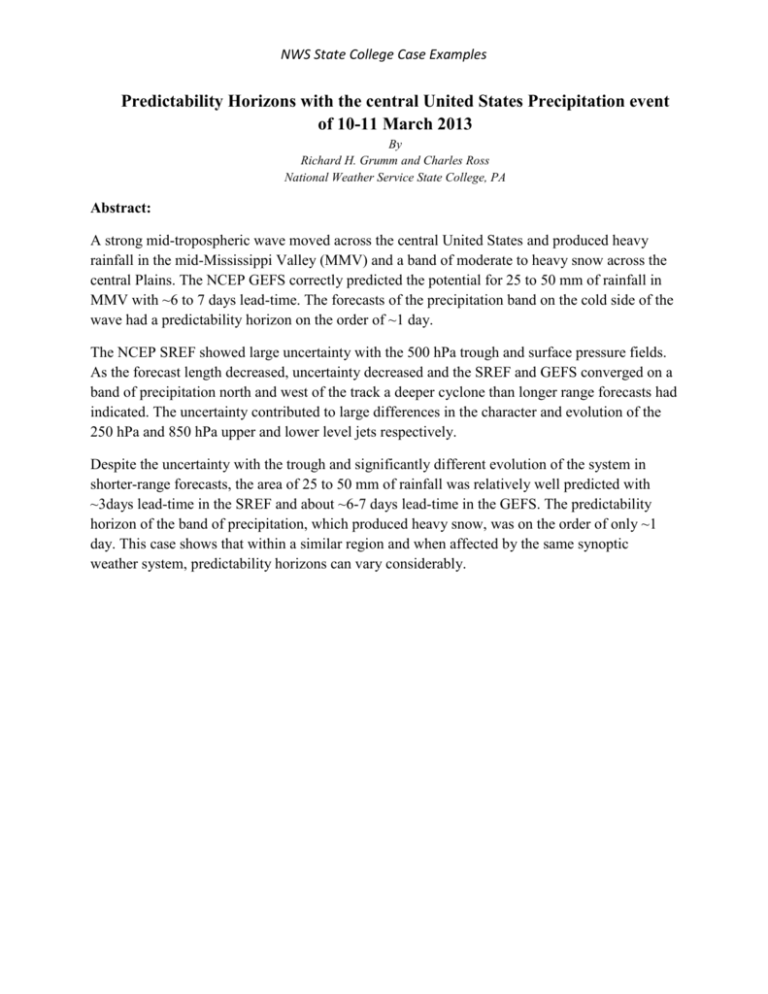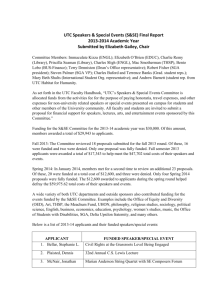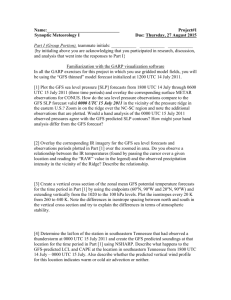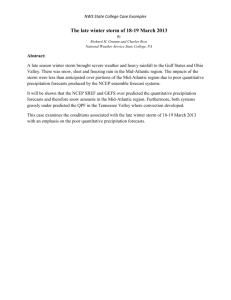11Mar2013
advertisement

NWS State College Case Examples Predictability Horizons with the central United States Precipitation event of 10-11 March 2013 By Richard H. Grumm and Charles Ross National Weather Service State College, PA Abstract: A strong mid-tropospheric wave moved across the central United States and produced heavy rainfall in the mid-Mississippi Valley (MMV) and a band of moderate to heavy snow across the central Plains. The NCEP GEFS correctly predicted the potential for 25 to 50 mm of rainfall in MMV with ~6 to 7 days lead-time. The forecasts of the precipitation band on the cold side of the wave had a predictability horizon on the order of ~1 day. The NCEP SREF showed large uncertainty with the 500 hPa trough and surface pressure fields. As the forecast length decreased, uncertainty decreased and the SREF and GEFS converged on a band of precipitation north and west of the track a deeper cyclone than longer range forecasts had indicated. The uncertainty contributed to large differences in the character and evolution of the 250 hPa and 850 hPa upper and lower level jets respectively. Despite the uncertainty with the trough and significantly different evolution of the system in shorter-range forecasts, the area of 25 to 50 mm of rainfall was relatively well predicted with ~3days lead-time in the SREF and about ~6-7 days lead-time in the GEFS. The predictability horizon of the band of precipitation, which produced heavy snow, was on the order of only ~1 day. This case shows that within a similar region and when affected by the same synoptic weather system, predictability horizons can vary considerably. NWS State College Case Examples 1. Overview A fast moving 500 hPa trough (Fig. 1) brought a surge of high precipitable (PW) air into the central Plains and Mid-Mississippi Valley (MMV:F02) as the trough moved eastward. In addition to the surge of a strong 850 hPa jet developed in the warm air (Fig. 3). Heavy rain was observed on the warm side of the storm system from the Central Plains to the MMV (Fig. 4). The 12-hourly accumulated precipitation shows when the precipitation fell over the region, including a band of snow over Nebraska and Iowa (Fig. 5b-d). On the northern fringes of the precipitation shield was a difficult to forecast band of moderate to heavy snow (Fig. 6). The key predictability issue with this event was the band of precipitation on the northern edge of the storm system. Longer range forecasts in the NCEP model and ensemble forecasts systems (EFS) had some difficulty developing the precipitation band which produced snow to the north of the surface cyclone. The 0900 UTC 8 March 2013 SREF QPF (Fig. 7) illustrates this point quite well. Note the absence of any QPF over 6.25 mm from northeastern Kansas into Wisconsin in these forecasts. These data show the general lack of significant precipitation mover the MMV and central Plains. Note that shorter range forecasts showed an increased potential for this band of precipitation and thus the threat of heavy snowfall. The predictability horizon of larger scale features, such as large ridges can be on the order of days. The Central European and Russian heat wave of July-August 2010 (Grumm 2011) was well predict over a week in advance (Grumm 2011:Fig. 9). The predictability horizon for cyclones and frontal systems is typically shorter and can show variability from system to system. Smaller scale and weakly forced systems typically have lower predictability horizons. Kalnay et al. (1998) stated the goal of ensemble forecasting “is to provide forecasters with an estimation of the reliability of the forecast, which, because of changes in the atmospheric predictability, varies from day to day and from region to region”. These SREF QPFs illustrate clearly that each event has its own unique predictability horizon. The focus of this paper is on the short-predictability horizon associated with the snow band north of the surface cyclone while at the same time the heavier precipitation to the south had a longer predictability horizon. The NCEP SREF and GEFS are used to show the features which were significant in predicting the event and how the predictability of this features changed with forecast length, resulting in short-predictability horizon for the band of snow. These features and their predictability played a critical role in the evolution of the heavy rainfall farther south in the MMV. 2. METHOD AND DATA NWS State College Case Examples The large scale pattern was reconstructed using the Climate Forecasts System (CFS) as the first guess at the verifying pattern. The standardized anomalies were computed in Hart and Grumm (2001). All data were displayed using GrADS (Doty and Kinter 1995). The precipitation was estimated using the Stage-IV precipitation data in 6-hour increments to produce estimates of precipitation during the 6,12,24 and 36 hour periods centered on 0000 UTC 11March 2013. Snowfall was retrieved from NWS public information statements. The NCEP GEFS and SREF data were used to show the larger scale forecasts of the pattern, the QPF, precipitation types, and uncertainty. The focus is on shorter-range forecasts and with the exception of mean QPF and probabilities of exceed 25 and 50mm QPF, only limited GEFS data is shown. Additionally, SREF data from 07 through 10 March were examined to show the low predictability of the synoptic features. Though QPF and probabilities were limited to forecasts from 8-10 March 2013 as the 7 March data did not capture the precipitation though 1200 UTC 11 March. GEFS data from 03 to 10 March were examined in the same context as the SREF. Due to the similarities in most fields the data shown here focus on how the GEFS and SREF precipitation shields evolved. This helped identify the different predictability horizons of the two broader areas of precipitation. 3. Forecasts The forecasts of the 500 hPa heights and height anomalies from the SREF mean over the central United States (Fig. 8) show a significant difference in the orientation and intensity of the 500 hPa trough. An examination of the spread of each member about the ensemble means (Fig. 9) shows large spread, over 80m, over the upper Great Lakes and 40-80m in the trough in the longer range forecasts which gradually dropped to under 40m by forecasts initialized at 09/0300 UTC. The higher spread at longer ranges was indicative of predictability horizon issues. The changes in the depth and orientation of the trough impacted the character of the 250 hPa wind field (Fig. 10) and the location of the 250 hPa cyclone, which in the mean wind field was not predicted until forecasts initialized at or after 09/0900 UTC. The 850 hPa wind (Fig. 11) and mean sea-level pressure (Fig. 12) fields were impacted by the uncertainty. As forecast length decreased, a close 850 hPa cyclone developed as did an increasingly strong 850 hPa easterly wind north of the cyclone. The surface field showed a similar evolution from a trough to closed cyclone in the MMV. All of the examined fields contained larger spread which decreased with time similar to the spread in the 500 hPa heights (Fig. 9) and the mean sea-level pressure (Fig. 13). The large uncertainty in the SREF fields and steady convergence of the forecasts toward the correct solution is readily summed up in the mean SREF QPF field (Fig. 7). Note that the QPFs are for a slightly shorter forecast window and do not include forecasts from 7 March 2013. The NWS State College Case Examples probabilistic SREF QPFs for 25 and 50 m (Fig. 14 & 15) showed the gradual evolution of northern precipitation shield with about ~1 day predictability horizon for 25mm or more QPF over northwestern Missouri and Iowa (Fig. 14c-e). Note as the uncertainty decreased that the high confidence in the 25 mm of QPF in the MMV increased, but the effect was more notable in the probability of 50mm or more QPF with smaller area, sharper eastern edge, and more westward forecast of the regions to be affected by 50mm or more QPF. The evolution of the QPF probabilities was telling with regard to forecasting heavy rainfall. The GEFS mean QPF (Fig. 15) and probability of 25m or more QPF (Fig. 16) of QPF were used to compare to those produced by the SREF. The GEFS mean field showed the same lack of precipitation over the central Plains and the focus of the heavier rainfall in the MMV. One GEFS member from 07/1200 UTC produced 25mm of QPF over portions of Iowa and Missouri (Fig. 15a) but a coherent signal did begin to emerge until 09/1200 UTC (Fig. 15e & 16e). Similar to the SREF, the GEFS offered at 3-days of predictability for the rainfall in the MMV but only about ~day for the precipitation over the central Plains. The GEFS 50mm probabilities (Fig. 17) show the increased predictability of the MMV rainfall area. Similar to the SREF, these forecasts showed higher probabilities of 50 mm or more QPF and a mean 50 mm contour over a more focused area for forecasts on the order of ~day in length. The predictability of rainfall over 50mm was present at least 3.5 days in advance in the correct area but the high probability outcome was slower to evolve. Though not shown the GEFS had 30 to 50% probabilities of 50mm or more QPF over portions of the MMV (Fig. 18) from forecasts issued at both 04/1200 and 05/0000 UTC. The potential MMV rainfall event had a ~6-7 day predictability horizon (not shown). The band of precipitation on the northern edge of the storm fell primarily as snow. This was also a region where the 850 hPa temperatures forecast to fall below 0C and were observed to be between 0C and -6C by 11/0000 UTC (not shown). The SREF indicated the highest potential for snow between 10/1800 and 11/1200 UTC (Fig. 19) and shorter-range forecasts indicated heavy snow focused between about 10/1800 and 11/0000 UTC (Fig. 20). The SREF initialized at 10/0900 UTC indicated a swath of 2 inches or more snowfall from northeast Kansas into southeastern Minnesota with an embedded area of 4 inches over Iowa and very small region of over 6 inches of snowfall. These 3-hourly data show the more intense snow from SREFs issued at 09/1500, 09/2100 and 10/0900 UTC. The “event total” snowfall showed some reduced snow potential in the 10/0300 UTC SREF (Fig. 18e). The longer range forecasts had relatively slow snowfall amounts (Figs. 18a-b) and earlier forecasts (not shown) indicated little snow potential due to little or no QPF and a warmer forecast solution. 4. Short range forecasts NWS State College Case Examples Despite the relatively short predictability horizon of the event by forecast systems in the 2-4 day timeframe, the event was relatively well captured by the high resolution short-term models. The analyzed radar from the RAP (Fig. 21) shows the relative areas of areas of precipitation bands. The band of snow over the central Plains was present by 10/1500 UTC and intensified over time peaking between 10/2100 and 11/0000 UTC (Figs. 21c-d). Forecasts from the RAP initialized from 12 to 17 UTC 10 March show the estimated radar at 10/1800 UTC and 11/0000 UTC(Figs. 22 & 23). These data show that the RAP provided clear signals as to the evolution of the snow band in the Plains and the intensity of the band increasing toward 11/0000 UTC (Fig.23). 5. Summary A short-wave moved through the central United States producing 25-645mm of rainfall in the MMV and areas of over 32mm of precipitation in the central Plains. The northern band of precipitation fell primarily in the form of snow. The rainfall in MMV and the potential of 25 to 50mm of QPF was relatively well predicted and had about ~6 day predictability horizon. The northern precipitation area, where the snow fell, was poorly predicted and the precipitation band which produced the snow had a predictability horizon of about ~1 to ~1.5 days. It is interesting to note that 2 areas of precipitation generate by the same synoptic scale system had widely varying predictability horizons. The precipitation over the MMV relied on the stream of deep moisture which evolved in both the deeper close mid-tropospheric wave scenario and the more open wave scenario. The precipitation band over the central Plains was dependent on the deeper closed low scenario which was poorly predicted by the NCEP SREF and GEFS with much more that ~1.5 days of lead-time. The NCEP SREF mean fields and anomalies showed the different evolution and when used with the mean and spread fields, they showed the areas of high uncertainty which played a critical role in the forecast uncertainty with both precipitation areas and were critical in varying the predictability horizons of both events. The spread was only shown for the 500 hPa heights and mean sea-level pressure fields (Fig. 9 & 13). These data showed the high spread in the longer range forecast with the northern trough and lower spread with the ridge to the east. As the spread decreased, with decreasing forecast length, the deeper more closed cyclone forecast scenario developed. This had a dramatic impact on the evolution of the QPFs as forecast length decreased. Figures 7, 14, & 15 show sensitivity of the SREF QPF fields were due to uncertainty and predictability issue associated with the developing mid-tropospheric cyclone and jet. Despite the large uncertainty in the trough and the axis of the trough, the heavy rainfall in the MMV had a ~2 day predictability horizon in the SREF and the GEFS indicated over 50mm of QPF in the general region of the MMV with ~6 days of lead-time. Despite this success, the band of heavy NWS State College Case Examples precipitation over the central Plains was poorly predicted and thus the potential for a late season snowfall was predicted with very limited lead-time, perhaps on the order of ~1 day. Human and machine generated forecasts need to account for uncertainty. Human forecasters need to be mindful of regions of high uncertainty and their impacts on the forecast. Kalnay et. al (1998) emphasized this point and why ensembles are a critical component of the forecast system. The large spread in the 500 hPa heights and mean sea-level pressure fields were clues as the low confidence in these forecasts. It is interesting that despite the high uncertainty with the evolution of the trough, surface cyclone, and jet structure, the surge of high PW afforded relatively high predictability for the rainfall in the MMV while with the same system the predictability of the precipitation in the cold air was so limited. In this case, the SREF and GEFS showed similar predictability issues and neither system provided any advantage over the other with the precipitation in the central Plains. One might speculate as to the similarity of the initial data used in each system and the role that might play. Events like this could be examined using other EFSs to see how they performed. The high-resolution 1-hourly updated RAP data (Figs.21-23) indicated that the RAP did relatively well predicting the mesoscale band north and west of the surface cyclone. Only 2 forecast periods were shown, but the 1-hourly updated data with real-time radar proved quite useful. These forecasts show that despite a relatively short predictability horizon when considered on the order of days, the event was relatively strongly forced and well predicted on the order of hours. How well forecasters can adapt to changing predictability horizons is an issue of further investigation. Though disseminated forecasts to users were not specifically examined, it is likely that the rainfall in the MMV was better anticipated and thus conveyed relative to the snow on the northern side of the event. In the interest of full disclosure, this event was examined due to information and a discussion related to the poor prediction with the snow in the Central Plains. 6. Acknowledgements 7. References Doty, B.E. and J.L. Kinter III, 1995: Geophysical Data Analysis and Visualization using GrADS. Visualization Techniques in Space and Atmospheric Sciences, eds. E.P. Szuszczewicz and J.H. Bredekamp, NASA, Washington, D.C., 209-219. Kalnay, Eugenia, Stephen J. Lord, Ronald D. McPherson, 1998: Maturity of Operational Numerical Weather Prediction: Medium Range. Bull. Amer. Meteor. Soc., 79, 2753– 2769. NWS State College Case Examples NWS State College Case Examples Figure 1. NCEP GFS 500 hPa heights (m) and height anomalies in 24 hour periods from a) 1200 UTC 8 March 2013 through f) 1200 UTC 13 March 2014. Contours every 60m. Return to text. NWS State College Case Examples Figure 2. As in Figure 1 except for precipitable water (mm) in 6-hour increments from a) 0000 UTC 10 March 2013 through f) 1200 UTC 12 March 2013. Return to text. NWS State College Case Examples Figure 3. As in Figure 2 except for 850 hPa winds (kts) and total wind anomalies. Return to text. NWS State College Case Examples Figure 4. Stage-IV estimated precipitation (mm) for 0000 UTC 10 March through 0000 UTC 12 March 2013 focused over the central United States. Return to text. NWS State College Case Examples Figure 5. As in Figure 4 except for the 12-hour precipitation estimates ending at a) 0000 UTC 10 March, b) 1200 UTC 10 March, c) 0000 UTC 11 March and d) 1200 UTC 11 March 2013. Return to text. NWS State College Case Examples Figure 6. Estimated snowfall (inches) for the event spanning 10 and 11 March 2012. Return to text. NWS State College Case Examples Figure 7. SREF forecasts of ensemble mean 24-hour QPF for value of 6.25mm (shaded) or greater and each members 25mm contour (colors) and the ensemble mean 25mm contour. Data valid for the period of 1200 UTC 10-11 March 2013 from SREF initialized at a) 0900 UTC 8 March, b) 0300 UTC 9 March, c) 0900 UTC 9 March, d) 1500 UTC 9 March, c) 2100 UTC 09 March, and f) 0300 UTC 10 March 2013. The yellow oval refers to the snow area referred to in the text which was poorly predicted. Return to text. NWS State College Case Examples Figure 8. NCEP SREF forecasts of ensemble mean 500 hPa heights (m) and standardized anomalies valid at 1800 UTC 18 March 2013 from SREFs initialized at a) 0000 UTC 07 March, b) 0900 UTC 8 March, c) 0300 UTC 9 March, d) 0900 UTC 9 March, e) 1500 UTC 09 March a,d f) 2100 UTC 9 March 2013. Return to text. NWS State College Case Examples Figure 9. As in Figure 8 except for NCEP SREF ensemble mean 500 hPa heights and the spread of the different SREF forecasts about the mean (m). Return to text. NWS State College Case Examples Figure 10. As in Figure 8 except for 250 hPa winds and v-wind anomalies. Return to text. NWS State College Case Examples Figure 11. As in Figure 8 except for SREF 850 hPa winds and 850 hPa wind anomalies valid at 2100 UTC 10 May 2013. Return to text.- NWS State College Case Examples Figure 12. As in Figure 8 except for SREF mean sea-level pressure and standardized anomalies. Return to text. NWS State College Case Examples Figure 13. As in Figure 12 except showing mean sea-level pressure and the spread of the members about the ensemble mean. Return to text. NWS State College Case Examples Figure 14. As in Figure 7 except for SREF probability of 25mm or more QPF for the period ending at 1200 UTC 11 March 2013. Solid black line is the 25mm contour if present. Return to text. NWS State College Case Examples Figure 15. As in Figure 14 except for 50mm QPF threshold values. Return to text. NWS State College Case Examples Figure 16. As in Figure 7 except for NCEP GEFS from GEFS initialized at a) 1200 UTC 7 March, b) 0000 UTC 8 March, c) 1200 UTC 8 March, d) 0000 UTC 9 March, e) 1200 UTC 9 March, and f) 0000 UTC 11 March 2013. Return to text. NWS State College Case Examples Figure 17. As in Figure 16 except for the probability of exceeding 25mm or more QPF in the 24 hour period ending at 1200 UTC 11 March 2013. Return to text. NWS State College Case Examples Figure 18. As in Figure 17 except for the probability of exceeding 50mm of QPF. Return to text. NWS State College Case Examples Figure 19. NCEP SREF forecasts of the probability of snow precipitation type (shaded) and the accumulated mean snow precipitation (inches) for the period of 1800 UTC 10 March through 1200 UTC 11 March 2013 from NCEP SREF initialized at) 0300 UTC 9 March 2013, b) 0900 UTC 9 March 2013, c) 1500 UTC 9 March 2013, d) 2100 UTC 9 March 2013, e) 0300 UTC 10 March 2013 and f) 0900 UTC 10 March 2013. Snow amounts use a simple 10:1 ratio to make full inches of snow QPF. Return to text. NWS State College Case Examples Figure 20. As in Figure 19 except for ensemble snow probabilities and amounts for the 3-hour period ending at 0000 UTC 11 March 2013. Return to text. NWS State College Case Examples Figure 21. 13km RAP estimated reflectivity (dBZ) form 00-hour forecasts valid in 3-hour increments from a) 1500 UTC 10 March 2013 through f) 0600 UTC 11 March 2013. Reflectivity in dBZ as in the color scale at the bottom of each image. Return to text. NWS State College Case Examples Figure 22. As in Figure 21 except for forecasts valid at 1800 UTC 10 March from successive RAP forecasts every 1-hour from a) 1200 UTC 10 March through 1700 UTC 10 March 2013. Return to text. NWS State College Case Examples Figure 23. As in Figure 22 except forecasts valid at 0000 UTC 11 March 2013. Return to text. NWS State College Case Examples







